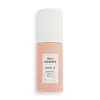What's inside
What's inside
 Key Ingredients
Key Ingredients

 Benefits
Benefits

 Concerns
Concerns

 Ingredients Side-by-side
Ingredients Side-by-side

Water
Skin ConditioningAscorbyl Glucoside
AntioxidantC15-19 Alkane
SolventNiacinamide
SmoothingPropanediol
SolventCaprylic/Capric Triglyceride
MaskingSodium Hydroxide
BufferingTocopherol
AntioxidantGlycerin
HumectantGlyceryl Stearate
EmollientBenzyl Alcohol
PerfumingCandelilla/Jojoba/Rice Bran Polyglyceryl-3 Esters
EmulsifyingFerulic Acid
AntimicrobialSodium Gluconate
Skin ConditioningCetearyl Alcohol
EmollientSodium Stearoyl Lactylate
EmulsifyingRicinus Communis Seed Oil
MaskingHydroxyethyl Acrylate/Sodium Acryloyldimethyl Taurate Copolymer
Emulsion StabilisingSodium Metabisulfite
AntioxidantSqualane
EmollientXanthan Gum
EmulsifyingEthylhexylglycerin
Skin ConditioningSodium Hyaluronate
HumectantParfum
MaskingPolysorbate 60
EmulsifyingHydrogenated Castor Oil
EmollientSorbitan Isostearate
EmulsifyingCoumarin
PerfumingLinalool
PerfumingGeraniol
PerfumingCitronellol
PerfumingEugenol
PerfumingWater, Ascorbyl Glucoside, C15-19 Alkane, Niacinamide, Propanediol, Caprylic/Capric Triglyceride, Sodium Hydroxide, Tocopherol, Glycerin, Glyceryl Stearate, Benzyl Alcohol, Candelilla/Jojoba/Rice Bran Polyglyceryl-3 Esters, Ferulic Acid, Sodium Gluconate, Cetearyl Alcohol, Sodium Stearoyl Lactylate, Ricinus Communis Seed Oil, Hydroxyethyl Acrylate/Sodium Acryloyldimethyl Taurate Copolymer, Sodium Metabisulfite, Squalane, Xanthan Gum, Ethylhexylglycerin, Sodium Hyaluronate, Parfum, Polysorbate 60, Hydrogenated Castor Oil, Sorbitan Isostearate, Coumarin, Linalool, Geraniol, Citronellol, Eugenol
Water
Skin ConditioningPropanediol
SolventCaprylic/Capric Triglyceride
MaskingAscorbyl Glucoside
AntioxidantSodium Citrate
BufferingPhenoxyethanol
PreservativeHydroxyethyl Acrylate/Sodium Acryloyldimethyl Taurate Copolymer
Emulsion StabilisingSodium Hydroxide
BufferingXanthan Gum
EmulsifyingCanola Oil
EmollientEthylhexylglycerin
Skin ConditioningDisodium EDTA
Polysorbate 60
EmulsifyingSorbitan Isostearate
Emulsifying1,2-Hexanediol
Skin ConditioningDaucus Carota Sativa Seed Oil
EmollientAcetyl Hexapeptide-1
Skin ConditioningHelianthus Annuus Seed Oil
EmollientBeta-Carotene
Skin ConditioningTocopheryl Acetate
AntioxidantDaucus Carota Sativa Root Extract
Skin ConditioningWater, Propanediol, Caprylic/Capric Triglyceride, Ascorbyl Glucoside, Sodium Citrate, Phenoxyethanol, Hydroxyethyl Acrylate/Sodium Acryloyldimethyl Taurate Copolymer, Sodium Hydroxide, Xanthan Gum, Canola Oil, Ethylhexylglycerin, Disodium EDTA, Polysorbate 60, Sorbitan Isostearate, 1,2-Hexanediol, Daucus Carota Sativa Seed Oil, Acetyl Hexapeptide-1, Helianthus Annuus Seed Oil, Beta-Carotene, Tocopheryl Acetate, Daucus Carota Sativa Root Extract
Ingredients Explained
These ingredients are found in both products.
Ingredients higher up in an ingredient list are typically present in a larger amount.
Ascorbyl Glucoside is a stable form of Vitamin C. It is created by combining glucose from starch.
When applied to skin, Ascorbyl Glucoside turns into Ascorbic Acid.
Ascorbyl Glucoside is an antioxidant. Antioxidants help fight free-radicals, or molecules that may damage skin cells.
It can help to reduce redness, improve skin texture, reduce the effects of aging, reduce the visibility of dark spots, and brighten skin.
Read more about other types of Vitamin C:
Learn more about Ascorbyl GlucosideThis ingredient is an emollient, solvent, and texture enhancer. It is considered a skin-softener by helping the skin prevent moisture loss.
It helps thicken a product's formula and makes it easier to spread by dissolving clumping compounds.
Caprylic Triglyceride is made by combining glycerin with coconut oil, forming a clear liquid.
While there is an assumption Caprylic Triglyceride can clog pores due to it being derived from coconut oil, there is no research supporting this.
Learn more about Caprylic/Capric TriglycerideEthylhexylglycerin (we can't pronounce this either) is commonly used as a preservative and skin softener. It is derived from glyceryl.
You might see Ethylhexylglycerin often paired with other preservatives such as phenoxyethanol. Ethylhexylglycerin has been found to increase the effectiveness of these other preservatives.
This is a synthetic polymer. It helps improve the texture of products by adding thickness and gel-like feel.
It is also an emulsifer, meaning it prevents ingredients such as oil and water from separating. It also helps evenly disperse other ingredients.
Polysorbate 60 is used to help stabilize products. It is a surfactant and emulsifier. These properties help keep ingredients together in a product. Surfactants help reduce surface tension between ingredients with different states, such as liquids and solids. Emulsifiers help prevent oils and waters from separating.
Polysorbate 60 is sorbitol-based and created from the ethoxylation of sorbitan. Ethoxylation is a chemical reaction used to add ethylene oxide. Sorbitan is a the dehydrated version of sorbitol, a sugar found in fruits.
In this case, the 60 comes from reacting 60 units of ethylene oxide with sorbitan.
Polysorbates are commonly used in medicine and foods.
Learn more about Polysorbate 60Propanediol is an all-star ingredient. It softens, hydrates, and smooths the skin.
It’s often used to:
Propanediol is not likely to cause sensitivity and considered safe to use. It is derived from corn or petroleum with a clear color and no scent.
Learn more about PropanediolSodium Hydroxide is also known as lye or caustic soda. It is used to adjust the pH of products; many ingredients require a specific pH to be effective.
In small amounts, sodium hydroxide is considered safe to use. However, large amounts may cause chemical burns due to its high alkaline.
Your skin has a natural pH and acid mantle. This acid mantle helps prevent harmful bacteria from breaking through. The acid mantle also helps keep your skin hydrated.
"Alkaline" refers to a high pH level. A low pH level would be considered acidic.
Learn more about Sodium HydroxideSorbitan Isostearate is an emulsifer and cleaning agent. It is created from isostearic acid and sorbitol.
As an emulsifier, Sorbitan Isostearate prevents oils and water from separating.
Due to its isostearic acid base, it may not be safe for Malassezia or fungal acne.
Learn more about Sorbitan IsostearateWater. It's the most common cosmetic ingredient of all. You'll usually see it at the top of ingredient lists, meaning that it makes up the largest part of the product.
So why is it so popular? Water most often acts as a solvent - this means that it helps dissolve other ingredients into the formulation.
You'll also recognize water as that liquid we all need to stay alive. If you see this, drink a glass of water. Stay hydrated!
Learn more about WaterXanthan gum is used as a stabilizer and thickener within cosmetic products. It helps give products a sticky, thick feeling - preventing them from being too runny.
On the technical side of things, xanthan gum is a polysaccharide - a combination consisting of multiple sugar molecules bonded together.
Xanthan gum is a pretty common and great ingredient. It is a natural, non-toxic, non-irritating ingredient that is also commonly used in food products.
Learn more about Xanthan Gum